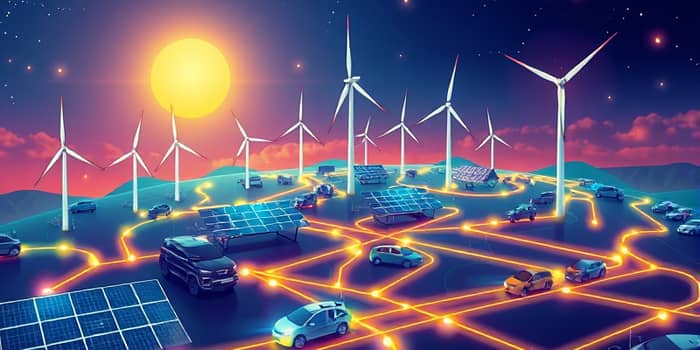2024 marked a profound turning point, as global green energy investment reached unprecedented heights. Capital flows into renewable projects and clean technologies have rewritten the rules of engagement, bringing us closer to a net-zero reality. The scale of investment signals not just an environmental imperative but a robust economic opportunity ripe for innovation.
From solar farms stretching across deserts to electric vehicles gliding silently through city streets, the momentum is unmistakable. Every new megawatt of renewable capacity and every electric mile driven represents collective progress toward a more sustainable and resilient world. This narrative explores the forces shaping this historic surge, the challenges ahead, and the steps we can take to accelerate the transition.
Global Investment Surge and Milestones
In 2024, investment in the energy transition soared to record $2.1 trillion in 2024, an 11% increase over the previous year. Total energy sector expenditures surpassed $3 trillion for the first time, with two-thirds—over $2 trillion—directed toward clean energy and infrastructure. Notably, clean energy outpaces fossil fuel investments by a ten-to-one margin for new power capacity.
Renewable energy alone attracted $728 billion in 2024, while electrified transport led with $757 billion and power grids accounted for $390 billion. According to market projections, the renewable investment market, valued at $1.36 trillion in 2023, is $3.1 trillion by 2032 with a 9.6% compound annual growth rate. This sustained momentum underscores the depth and breadth of global commitment.
Segment Breakdown: Where Capital Flows
The energy transition encompasses a diverse array of sectors, each vital to decarbonizing our economy. Understanding where capital is allocated helps stakeholders identify opportunities and emerging trends.
- Electrified transport: $757 billion invested in 2024, led by electric vehicles and charging networks.
- Renewable energy: $728 billion channeled into solar, wind, biofuels, and other zero-carbon sources.
- Power grids: $390 billion funding transmission, distribution, and digitalization upgrades.
- Energy storage: Rapid growth, with US battery capacity expected to reach 30.9 GW by year-end.
- Nuclear energy: $80 billion invested, nearly double the 2018 level, claiming 9% of new clean power funding.
- Clean industry and supply chain: $140 billion supporting manufacturing and logistical infrastructure.
Together, these segments create a complementary ecosystem that reduces emissions, enhances resilience, and opens new avenues for innovation and investment.
Regional Powerhouses Driving Growth
China continues to dominate global green energy expansion, accounting for roughly two-thirds of the incremental investment increase in 2024. Its massive manufacturing base and domestic deployments drive economies of scale, pushing down costs and accelerating global competitiveness.
In the United States, clean energy investment topped $300 billion—1.6 times the 2020 level—supported by the Inflation Reduction Act and other incentives that have spurred a projected 66.9% jump in solar deployment. The European Union directed $375 billion to grid projects and remains a leader in offshore wind and cross-border interconnections. Other regions, including India and parts of Latin America, are investing 1%–4% of GDP annually in renewable energy, reflecting a truly global shift.
Breakthrough Technologies and Innovations
At the forefront of this transition are solar and wind technologies. Solar photovoltaic and onshore wind costs have plummeted—69% drop from 2013 to 2022 for PV systems, 33% for onshore wind, and 45% for offshore turbines—establishing renewables as the cheapest new power sources in many markets. The United States installed over 41 GW of utility-scale solar in 2024 alone.
Rising data center demand is driving an additional 44 GW of renewable capacity by 2030 in the US, while residential and commercial solar paired with battery storage are becoming common features of new construction. Government incentives, from tax credits to low-interest loans, continue to catalyze private capital and de-risk investments across all major markets.
Challenges on the Road Ahead
Despite remarkable progress, several obstacles threaten to slow momentum. High financing costs, driven by elevated interest rates, have tempered the pace of new projects, particularly in emerging technologies such as green hydrogen and carbon capture. Grid connection constraints, equipment procurement delays, and labor shortages further complicate deployment timelines.
- Financing and interest rate pressures raising project costs.
- Equipment procurement and labor shortages causing bottlenecks.
- Regulatory complexity and permitting hurdles delaying deployments.
Addressing these challenges will require coordinated policy frameworks, investment in workforce development, and targeted support for nascent technologies to diversify and deepen the clean energy pipeline.
Outlook: Path to Net-Zero
The trajectory of green energy investment points toward sustained expansion, driven by both public and private capital. However, to align with net-zero goals, annual spending must climb from the current $1.9–2.1 trillion range to $5.3 trillion by 2035.
Already, clean energy investment crowds out fossil fuel spending for new capacity at a ratio of 1.7 to 1. This trend must accelerate, with stakeholders prioritizing projects that maximize impact and scalability, from grid modernization to next-generation storage.
Conclusion: A Call to Action
Green energy investments represent an unprecedented opportunity to reshape our global economy and environment. Governments, businesses, and individuals all have roles to play. Investing in renewable infrastructure, advocating for supportive policy, and embracing clean technologies for a resilient future can ensure a thriving net-zero world.
The next decade is critical: let us accelerate momentum and turn today's capital flows into tomorrow's sustainable prosperity. Together, we can finance a greener planet and secure a legacy of environmental stewardship for generations to come.
References
- https://about.bnef.com/blog/global-investment-in-the-energy-transition-exceeded-2-trillion-for-the-first-time-in-2024-according-to-bloombergnef-report/
- https://www.iea.org/reports/world-energy-investment-2024/overview-and-key-findings
- https://www2.deloitte.com/us/en/insights/industry/renewable-energy/renewable-energy-industry-outlook.html
- https://seia.org/research-resources/solar-industry-research-data/
- https://www.zionmarketresearch.com/report/renewable-energy-investments-market
- https://en.wikipedia.org/wiki/Renewable_energy
- https://www.iea.org/reports/world-energy-investment-2023/overview-and-key-findings










